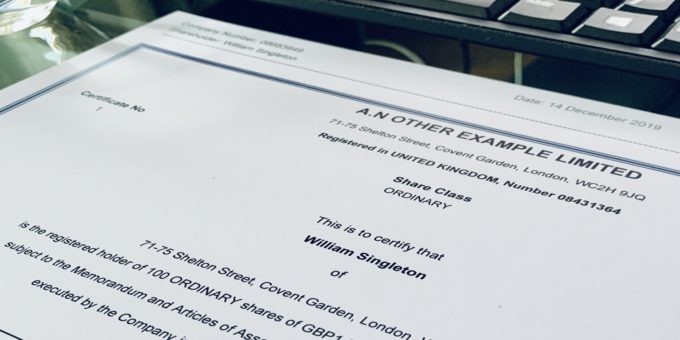A share certificate is a document that verifies a person’s shareholdings in a company. Created and issued by companies limited by shares, a certificate is essentially a dated receipt proving that the named person is the registered owner of a certain class (type) and quantity of shares in a company.
The Companies Act 2006 (section 768) defines a share certificate as “prima facie evidence” (i.e., accepted as correct until proved otherwise) of a person’s title to the specified shares. For companies registered in Scotland, a certificate “is sufficient evidence, unless the contrary is shown, of his title to the shares”.
How and when to issue share certificates
Companies must issue share certificates to shareholders (members) when new shares are allotted (issued) and when existing shares are transferred from one person to another.
In accordance with the Companies Act 2006 (part 21) and the model articles of association (part 3), certificates must be issued to members no later than two months after the allotment or transfer of shares has taken place.
This timeframe applies to shares issued on incorporation and those issued or transferred after incorporation.
What information should be included on a share certificate?
You can design your own branded share certificate featuring your company logo, or you can use a template from a legal stationer or company formation agent. It’s entirely up to you whether share certificates are issued and stored on paper or in digital format.
The following information should be included on a share certificate:
- company name and company registration number
- registered office address
- unique certificate number
- date of issue
- class (type) of share(s) being issued or transferred
- number of shares issued or transferred
- name and correspondence address of the new shareholder
- nominal value of the share(s)
- amount paid (or treated as paid) on the share(s)
Each certificate must be signed by two directors or one director and one company secretary. However, if you are the sole director and do not have a company secretary, a witness must be present and provide the second signature.
At 1st Formations, we have created a standard share certificate template that is suitable for a private company limited by shares with ‘Ordinary’ shares. You may wish to use this for your company or simply as a reference for your own design:
The company should keep a copy of every share certificate, but there is no need to provide copies to Companies House or HMRC.
Do I have to issue a separate share certificate for each share?
The model articles of association (part 3, article 24.—1) states that a “company must issue each shareholder, free of charge, with one or more certificates in respect of the shares which that shareholder holds.”
This means that you can issue one certificate per shareholder for all shares in the same class that are issued or transferred to that person on a certain date.
Alternatively, you can issue separate certificates for each individual share, even if they’re all being taken by the same shareholder.
Generally, companies will only ‘split’ share certificates when requested by a shareholder or if the articles stipulate this requirement. However, when shares of different classes are being issued or transferred, you must issue separate certificates for each class.
Updating the register of members and PSC register
Upon issuing or transferring shares, a company must also update its register of members and register of people with significant control (PSC) accordingly. These statutory registers are normally kept at the registered office address.
When new shares are issued, the company should record in its register of members (where applicable):
- the name and address of every new shareholder
- the date(s) on which they became members
- the class and quantity of shares held
- the amount paid or agreed to be paid on each share
When shares are transferred, the company should record in its register of members (where applicable):
- the name and address of every new shareholder
- the date(s) on which they became members
- the date(s) on which any person ceased to be a member upon transferring shares
- the updated shareholdings of any member who transferred shares
The PSC register only needs to be updated if an allotment or transfer of shares triggers any change to the company’s PSC information.
Issuing a replacement share certificate
When a certificate is lost, stolen, destroyed, damaged, or defaced – the old certificate must be cancelled and the shareholder will be issued with a replacement share certificate.
The shareholder may be required to comply with any conditions imposed by the company with respect to:
- evidence or an explanation
- indemnity against potential liability incurred by the company
- payment of a reasonable sum to cover any associated costs
In the case of any certificate that is damaged or defaced, the shareholder must return the original to the company.









